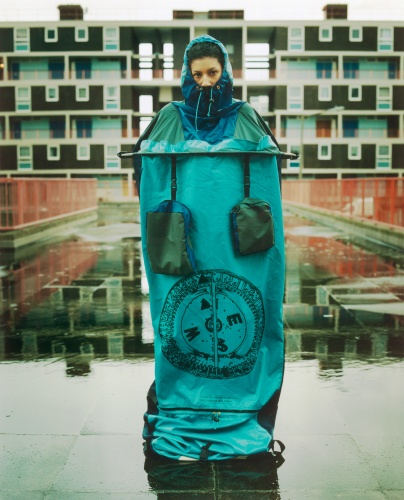Refuge Wear Intervention London East End 1998
Date:
1998
Ref:
2000
Materials:
Lambda photograph, laminated on Dibond
Dimensions:
170h x 120 cm
Catalogued:
Cover, p41 Lucy Orta, Phaidon Press UK 2003; p42 Lucy Orta Body Architecture, Verlag Silke Schreiber 2003
Exhibition history:
2019 Het Nieuwe Instituut, Rotterdam, The Nederlands; 2006 Gallery Continua Beijing, China; 2005 Barbican Art Galleries, The Curve, London; 2001 USF Contemporay Art Musem Tampa, USA
Courtesy:
Lucy + Jorge Orta
Refuge Wear (1992-98), are temporary shelters and architectures that can be transformed into clothing to offer protection from harsh conditions and shelter in emergency situations. The series, which Lucy Orta began working on during a period of economic recession provoked by the Gulf War and subsequent stock market crash, combines a dual response to this unprecedented global crisis. They are poetic responses to the humanitarian aid appeals for shelter and clothing for the Kurd refugees fleeing the war zones, and to the increasing numbers of homeless people on the streets of Paris.
Refuge Wear are portable habitats that convert into anoraks and backpacks, designed for personal comfort and mobility for nomadic populations. The transformation from shelter to clothing and vice versa is fundamental to the concept of freedom of movement, free will or choice, new relationships and new cultural exchanges, the homo mobilis. They incorporate arm and hood appendages, or pockets that contain both functional and symbolic objects. Their ergonomic forms allow for a minimum vital body space and they employ cutting-edge design innovations such as telescopic carbon armatures that raise the fabric above the chest to eliminate the effects of claustrophobia. The materials contain technical properties such as microporous Rip Stop with or PU coatings, metaphors for body comfort and protection.
Throughout the 1990's Lucy + Jorge Orta staged public interventions to challenge acts of social disappearance and to render the invisible populations, visible once more. Peripheral urban spaces such as squats, railway stations, housing projects, bridges and subways were chosen as arenas for simultaneous happenings. These interventions –warnings, alarm bells, distress whistles– signal out social issues that the media were ignoring at that time. The interventions staged in London’s East End were commissioned by Dazed and Confused and photographed by John Akehurst.

